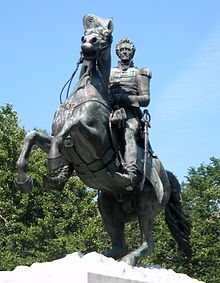Clark Mills (sculptor)
Clark Mills (September 1, 1815 – January 12, 1883) was an American sculptor, best known for four versions of an equestrian statue of Andrew Jackson, located in Washington, D.C., with replicas in Nashville, Tennessee, Jacksonville, Florida, and New Orleans, Louisiana.
[3][1]: 145–6 E. Wayne Craven, author of the 1968 book Sculpture in America, wrote that "What he learned he acquired from the life-mask itself, and this established his style as one strongly dependent upon naturalism.
The bust is in the Charleston's City Hall Museum; a bronze version was formerly in the Corcoran Gallery of Art in Washington, D.C.[3] Clark Mills had a number of studios and foundries.
[3][2] In 1849, in order to produce the Jackson equestrian statue, Mills built a temporary furnace and studio on the Ellipse at 15th and Pennsylvania Avenue, near LaFayette Square.
[5] Mills purchased a parcel on the border of Maryland and the District of Columbia where is constructed his mansion and a large octagon-shaped studio and foundry on Bladensburg Road.
[5] Mills' most well-known sculpture is the equestrian statue of Andrew Jackson, located in President's Park, also known as Lafayette Square, which is situated on the north portico side of the White House.
Mills' sculpture depicted Major Jackson on a rearing horse, raising his hat to the troops he was reviewing at the Battle of New Orleans on January 8, 1815.
[3] He won the competition to create the statue in 1848 and moved from Charleston to Washington, bringing with him the enslaved master craftsman, Philip Reid (c. 1820 – February 6, 1892), whom he had purchased in 1842.
[8] Mills unveiled the 15 ton bronze statue of Andrew Jackson on January 8, 1853, the 38th anniversary of the Battle of New Orleans and according to one account by a reporter for the Washington Union, twenty thousand people attended in and around the park.
The elaborate high pedestal that Mills originally designed, with three tiers of sculptured relief panels and smaller equestrian statues of Washington's generals, were never executed because of a lack of adequate funds.
[11] Beginning in 1860, the Statue of Freedom, which was designed by Thomas Crawford and sits atop the United States Capitol, was cast in five main sections by Mills with the assistance of Philip Reid.
By 1862, he had eleven slaves working for him—Lettie, Tilly, Tow, Ellick, Jackson, George, Emily, and Levi Howard, Rachel Thomas, Auw Rofs and Philip Reid.




